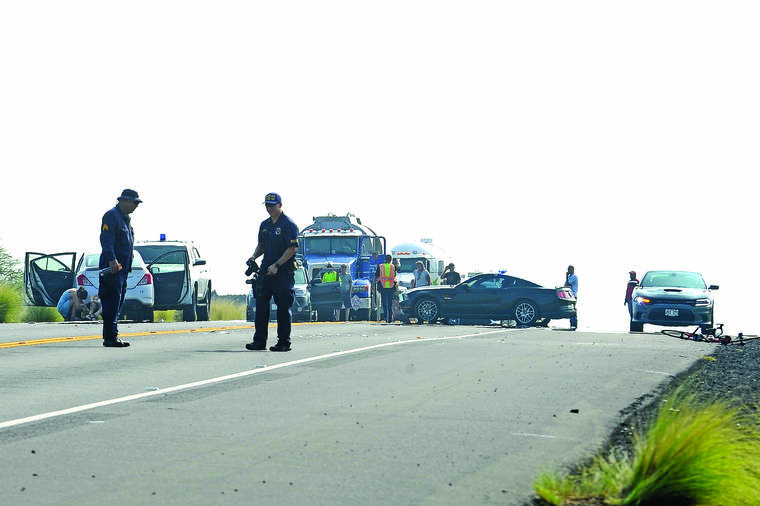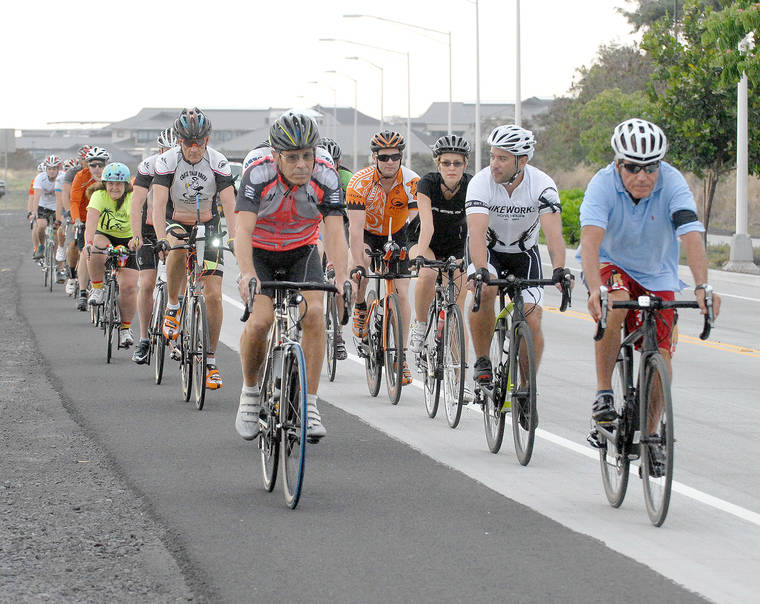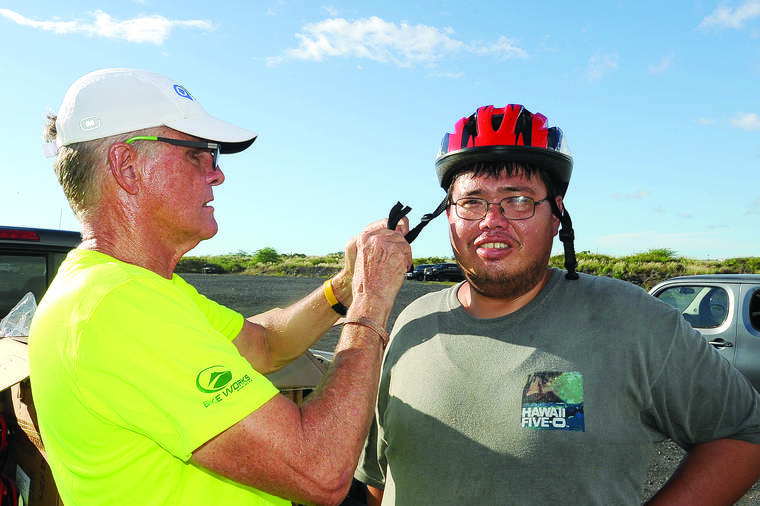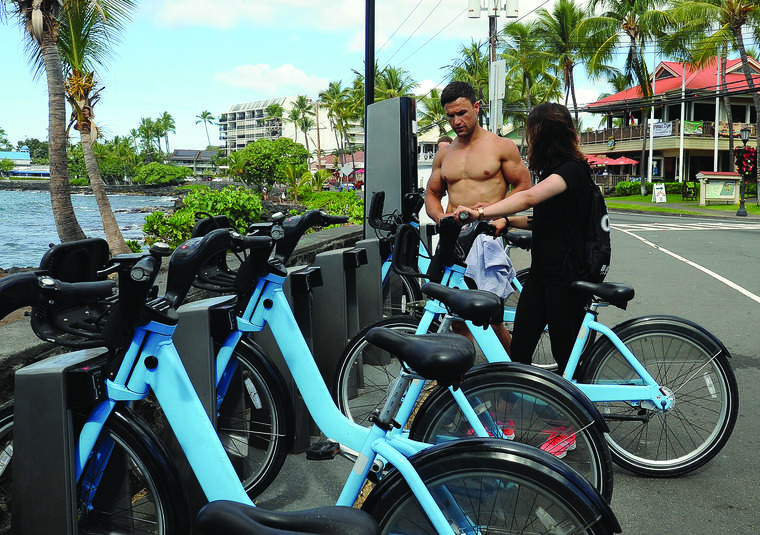KAILUA-KONA — Two years ago, Franz Weber was riding his bicycle when he struck a delineator pole as he cruised at no more than 10-15 mph.
The crash sent him tumbling from atop his bike 6-7 feet down to the pavement, fracturing three vertebrae in his neck in the process. His helmet was cracked “completely open” from front to back in the accident.
Weber was seriously wounded. But, the avid cyclist and cycling safety advocate did not suffer a head injury, or worse.
“Without the helmet, I would be in a very different situation,” Weber said, adding he was back on his bike about five weeks later. “Without the helmet, I would definitely had more broken (vertebrae in my) neck and it would have taken months and months (to get back on the bike). There’s no question.”
Head injury most
common cause of
death in bicycle crashes
Head injury is the most common cause of death and serious disability in bicycle-related crashes, according to the Centers for Disease Control and Prevention. It accounts for 62% of bicycle-related deaths.
In addition, approximately 33% of all bicycle-related emergency department visits and 67% of all bicycle-related hospital admissions involve head injuries, the CDC said.
While several researchers have recommended bicyclists use helmets to prevent head injuries, controlled studies have been limited. One such study in Seattle in 1989 found the use of helmets reduced the risk for bicycle-related head injury by 74%-85%. Other studies showed a higher risk among un-helmeted riders.
“Helmets save lives and prevent traumatic brain injuries,” said Lt. Gov. Josh Green, who is still a practicing ER doctor on the Big Island. “Everyone should wear a helmet if they are riding a bike.”
NTSB: States should require bicyclists to wear helmets
On Tuesday, the National Transportation Safety Board (NTSB) recommended that all 50 states enact laws requiring bicyclists to wear helmets to stem an increase in bicycle deaths on U.S. roadways. It was the first time the board has issued a report on bicycle safety since 1972.
According to the federal agency, 857 bicyclists died in crashes with motor vehicles in the U.S. last year, a 6.3% increase over 2017. Research shows fewer than half of bicyclists wear helmets, according to the NTSB.
In Hawaii, there were three fatal bicycle crashes, one on the Big Island and two on Oahu, in 2018, down from six in 2017, including three on the Big Island. In 2016, no fatal crashes involving bicycles occurred across the Hawaiian Islands.
So far this year, the Big Island has recorded one fatality involving a cyclist, bringing the statewide total number of fatalities involving cyclists to three. On Wednesday night, an alleged drunken driver struck 40-year-old Wayne Geil as he rode on Kaumana Drive in Hilo. Police have yet to confirm whether the victim was wearing a helmet.
“If we do not mitigate head injury for more bicyclists, additional bicyclists will die,” NTSB Chairman Robert Sumwalt said.
The NTSB also found that improved road designs to separate bicycle and vehicle traffic, and making bicyclists more visible through clothing, lights and technology would reduce the number of cyclist deaths.
Currently, no federal law mandates helmet use by bicyclists.
In addition, none of the 50 states have enacted laws requiring all bicyclists to wear helmets, though many mandate them for younger riders, according to the Governors Highway Safety Association.
Hawaii is among those states requiring head protection for youth. In the Aloha State, those age 15 and younger have had no choice but to wear a helmet or their parents or legal guardian could face a $25 fine since 2000.
Gov. David Ige, in a prepared statement, said Friday that the well being of Hawaii residents is a high priority for him and the administration, which “will continue to work with highway safety stakeholders to consider the recommendations in the NTSB safety research report.”
“I encourage everyone to learn about and follow the rules of the road so they can get to their destinations safely. For bicyclists, we encourage the use of properly fitted and fastened bicycle helmets. This is the law for those under the age of 16. We also encourage motorists to watch for vulnerable users such as bicyclists and pedestrians on the road. It goes without saying that anybody who is under the influence of alcohol or other substances should never drive,” Ige said.
His lieutenant governor was more assertive.
“There’s no question that we should have the helmet law,” said Green. “And, it should also be extended to everyone that is on a motorcycle or moped — but bicycles would be a great place to start.”
Green said if a bicycle helmet measure passed the Legislature, “I would definitely sign that bill if the governor was out of town.”
Kona Community Hospital spokeswoman Judy Donovan said the level III trauma center’s team agrees with the NTSB recommendation and the use of helmets among all ages.
“The Kona Community Hospital Trauma Center supports the NTSB’s recent helmet law recommendations,” said Donovan, “bike helmets are an effective way to prevent head injuries from bicycle crashes.”
According to state Department of Health data, from 2013 to 2017, an average of 238 cyclists were treated for traumatic brain injury annually at Hawaii County’s six hospitals.
Of those requiring treatment, 196 suffered injury in accidents not involving a motor vehicle. Statewide, hospitals treated on average 1,642 cyclists for traumatic brain injury. The CDC defines a traumatic brain injury as a disruption in the normal function of the brain that can be caused by a bump, blow, or jolt to the head, or penetrating head injury.
Legislative action
and pushback
Attempts have been made over the years to enact a helmet law for all bicyclists in Hawaii, as well as helmet laws for moped riders, motorcyclists and others on roadways, but it’s feat that has been difficult politically.
Most recently, Hawaii legislators last session introduced a bill to enact a universal helmet law requiring all operators and riders of motorcycles, motor scooters, mopeds and bicycles to wear safety helmets.
That measure, co-introduced by a handful of House members including Rep. Richard Creagan (D-Naalehu, Ocean View, Captain Cook, Kealakekua and a portion of Kailua-Kona), died after passing first reading.
Creagan, reached Tuesday, said he suspects the bicycle helmet discussion will come up again during the upcoming session that opens in mid-January. Oahu Rep. Tom Bower, a helmet proponent who’s also introduced legislation, albeit unsuccessfully, over the years, agreed.
“As a physician, I think that this is a health issue,” Creagan said. “It should be addressed considering how many more bike riders and inexperienced bike riders we have in downtown Honolulu.”
Weber, the cyclist, suggested it’s lobbying on the behalf of motorcycle rights groups that’s keeping a law from being passed — even if it’s only for people on pedal- not engine-driven bicycles.
“I think they figure if the bicycles are required then how can you say motorcycles don’t?” Weber asked.
Currently, 19 states plus Washington, D.C., require motorcyclists to wear helmets, while 28 require them mainly for younger riders and three states have no requirement, according to the Governors Highway Safety Association. Hawaii requires riders younger than 18 to wear a helmet.
Most motorcyclists contacted by West Hawaii Today believe it should be an adult’s choice to wear a helmet, but referred the newspaper to contact the Hawaii Street Bikers United, an motorcycle rights advocacy group, for comment.
“There are numerous situations where helmets can be very beneficial in the event of a crash, whether it be a single-vehicle crash or it involves another automobile or stationary object on or off the road,” said Bruce Paige, the group’s state director who handles legislative issues. “We always take the position that our members should have the right to choose as adults. But for anyone under the legal age, of majority, we have always taken the position that they aren’t really mature adults who’ve had all the life experiences necessary to make that decision and therefore we feel it should be mandatory” (for minors).
Paige, who rides both motorcycles and bicycles, feels the same about helmets for bicyclists — give adults the choice.
He chooses to wear a helmet when bicycling, but not riding a motorcycle, because, as he explained, helmets are more effective at reducing injury in slower speed crashes rather than accidents at highway speeds on a motorcycle.
“It’s just generally advisable, in my respectful opinion, for me to wear one, but I would never argue that all adult bicyclists should wear one,” said Paige. “That should be a matter of personal choice. And we take the same position with motorcycles.”
As for concern of legislative action — even if just for bicycle helmets for all ages — Paige said the advocacy group isn’t “really worried about it.”
“We actually fight helmet laws all the time anyway,” he said. “We take the position that other avenues exist” to increase safety like drivers education, driver awareness and motorcycle training.
Efforts beyond the Legislature
While legislative action is the only way to mandate helmet use among all cyclists, a variety of community groups, organizations and businesses work together to promote the use of helmets among cyclists, particularly youth. There’s also the Vision Zero Task Force working to eliminate all traffic fatalities and severe injuries while increasing safe, health and equitable mobility for all.
Peoples Advocacy for Trails Hawaii, a Kailua-Kona-based bicycle and pedestrian advocacy organization, is one such group providing educational programs for both adults and children in bike safety, among other tasks like working with state and county leaders to safety connect people and places on Hawaii Island.
“PATH encourages all cyclists to wear bike helmets while cycling out on roadways,” said Val Overlan, executive director. “It’s just been proven time and time again that bike helmets do help save lives.”
This year alone, PATH will visit fourth-graders at 22 schools on the Big Island as part of its education classes for youth.
“We will be giving out close to 1,400 bike helmets,” said Overlan, the nonprofit’s executive director.
Supporting that effort is Kona Community Hospital, according to Overlan and Donovan.
“Since our certification in 2011, the KCH Trauma Center has annually donated 800 to 900 multi-use helmets to support PATH’s bike education classes for fourth graders. The goal is to teach bike safety skills to children, who will continue to use those skills as they grow up,” Donovan said.
Weber, who’s also affiliated with PATH, also makes a point to give out helmets to those who might not be able to afford head protection.
“I help distribute helmets to the homeless,” he said, noting that sector of the population often uses bicycles on the roadway without protection for the noggin. “That’s important.”
The Associated Press and Washington Post contributed to this report.













